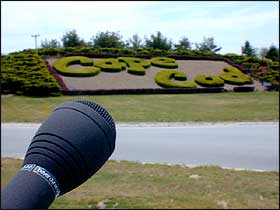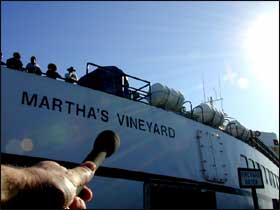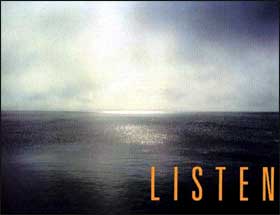Sonic Signatures- Tips for Creative Use of Interstitial Time
07/12/05 by Jay Alllison
 At our radio stations (WCAI/WNAN/WZAI for the Cape and Islands in Massachusetts), we have been experimenting with interstitial time since the day we signed on. By interstitial time, I mean the cutaways, the hourly breaks, all the little moments between programming blocks, the cracks in the sidewalk.
At our radio stations (WCAI/WNAN/WZAI for the Cape and Islands in Massachusetts), we have been experimenting with interstitial time since the day we signed on. By interstitial time, I mean the cutaways, the hourly breaks, all the little moments between programming blocks, the cracks in the sidewalk.
We use that time to create our station signature, to declare our sensibility in 30, 60 and 90 second bursts.
Sonic IDs
Our first experiment is something we dubbed, “Sonic IDs,” an odd name that stuck. These are little community vignettes — portraits, anecdotes, oral histories, overheard conversation, short poems, jokes, slices of life — that end with our call letters. They are sudden narratives or images — like photographs for radio. Some are pure sound preceded by our favorite word: “Listen.” Others are simply the unheralded voices of our neighbors telling something about life. Our test of these surprising, non-standard moments, the way we know they work, is if the listener turns and looks at the radio when the come on. (Current article: “Bursts of lush and local life are new stations’ trademark“.)
Sonic ID– “Couldn’t Buy Hard Tack” (1:00 mp3):
Story Line
 Gathering tape in the field can be expensive, even when we loan tape recorders to listeners as we do, so we have also instituted a kind of “Story Line” with voice mail. This idea grew from the national projects we’ve worked on (Lost & Found Sound, Sonic Memorial, Hidden Kitchens, This I Believe). We issue invitations to listeners to tell us a story about, well… anything: like, storms or fathers or fish. People leave us messages and we edit and air their stories. Other people hear them and send in stories of their own. The wall between listener and station becomes more porous, the relationship collaborative.
Gathering tape in the field can be expensive, even when we loan tape recorders to listeners as we do, so we have also instituted a kind of “Story Line” with voice mail. This idea grew from the national projects we’ve worked on (Lost & Found Sound, Sonic Memorial, Hidden Kitchens, This I Believe). We issue invitations to listeners to tell us a story about, well… anything: like, storms or fathers or fish. People leave us messages and we edit and air their stories. Other people hear them and send in stories of their own. The wall between listener and station becomes more porous, the relationship collaborative.
Our notion: Listeners are content.
(Hearing Voices worked with WCAI to get their IDs on NPR…)
Short List
 One of our favorite of these projects is called “Short Lists.” We ask people to call with a list and then tell us what it was. It’s a story with the title at the end. These are endlessly interesting. We have a feature of this on Transom.org, so you can check there to listen, or submit your own!
One of our favorite of these projects is called “Short Lists.” We ask people to call with a list and then tell us what it was. It’s a story with the title at the end. These are endlessly interesting. We have a feature of this on Transom.org, so you can check there to listen, or submit your own!
Short List– “Self Portraits #1” Monika Mueller (0:49 mp3):
(NPR Day to Day also collaborated w/ WCAI on a series of our short-lists…)
Moments Of America
 Our latest interstitial experiment is a collaboration with our parent station, WGBH in Boston. That venerable institution has a significant archive, from both radio and TV, of the voices of thoughtful people going back over fifty years. The list is impressive. But it is out of circulation. We decided to mine it for interstitial moments, believing that the legacy of public broadcasting is central to our identity now. We have produced a pilot series of these moments and imagine that other stations might do the same, finally creating a lending library of such moments which all stations could share. You can “” hear and download these pieces on the PRX.
Our latest interstitial experiment is a collaboration with our parent station, WGBH in Boston. That venerable institution has a significant archive, from both radio and TV, of the voices of thoughtful people going back over fifty years. The list is impressive. But it is out of circulation. We decided to mine it for interstitial moments, believing that the legacy of public broadcasting is central to our identity now. We have produced a pilot series of these moments and imagine that other stations might do the same, finally creating a lending library of such moments which all stations could share. You can “” hear and download these pieces on the PRX.
Moments of America– “Eleanor Roosevelt” (1961; 1:00 mp3):
Here area few tips for making these short interstitial pieces:
Resist Titling: There is a titling instinct in broadcasting, a need to order and frame, to tell the listener what to expect. Don’t do it. Let these voices appear without some catchy header like “Voices of Iowa.” Since you work in public broadcasting, you probably even want to include a colon and a sub-title. Resist! Just let it play.
Keep Copy to a Minimum: For our IDs, we say the speaker’s name and where the person is from. That’s it. If we absolutely have to, we’ll add a phrase about the work or some other context that’s key to understanding the story or the ambience. But be stingy with explanations! For “Moments of America,” we don’t even identify the line of work of the speaker. It challenges the listener a little more, but challenge is good.
Placement of Copy: It’s nice when the piece can open with the voice of the principal speaker rather than your announcer. It’s much more arresting. See if there’s a nice spot to insert the name/place of the speaker after they start. Some pieces work best not having the speaker identified until the very end. Embrace mystery, drama, and surprise.
Fit Your Voice to the Spot: Don’t be generic. Get the right tone. Read copy for each piece as if you’re listening to it along with the listener. Be real, be honest. Don’t do a fake smile or comment with your voice or try to “sell” the spot. Just be in it. Connect.
Your Calls Are Your Signature: We like to end our pieces simply with our station call letters. It’s the signature on the signature. It gives you a way to end.
Consider a P.S.: Sometimes a last little comment after the ID can be the perfect touch, a post-script, a second punch-line.
Find a Good Ending: A good ending forgives a soft middle and even a slow beginning. When auditioning your raw tape, listen for endings first.
Who Are You: This project will challenge you to declare your identity as a radio station. What defines you? What connects you to your listeners? Is it place? Is it sensibility? Our Sonic IDs trade on the former, the MOA project on the latter.
Postcard Reality vs. Real Reality: When you start a project that’s grounded in localness, you may find that you go to the postcard version of your place first. That’s okay. Go to Fenway Park or Niagra Falls or Schwab’s Drugstore first and get it out of your system. Actually, your listeners may find the postcard comforting, but they’ll tire of it quickly. Soon, move your pieces to less conventional subjects, or add some surprise to the conventional images.
Be Creative in Your Invitation: Sometimes the party is only as good as the invitation. When you ask for stories or contributions, produce the request with the same care you will produce the result. It lets people know you really care and that you are approaching the project with creative energy. They will respond in kind.
Trust Your Listeners: Trust them to understand what you’re doing and need less help than you think they do. The more you challenge them, the more they’ll enjoy the challenge. Trust them to have interesting stories. Many of them do. Trust them enough to loan them tape recorders.
Jay Allison is founder and executive producer of Cape and Islands Radio. The stations are a local service of WGBH, Boston. Allison, Viki Merrick, Helen Woodward and Jim Sulzer are the major producing team for the i.d.’s. Allison is also executive director of Atlantic Public Media and a longtime independent producer.
Listen to a Sonic ID Map of Montana.